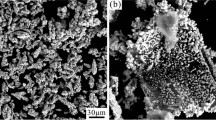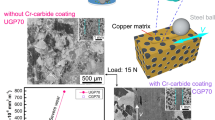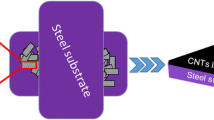Abstract
The effect of pressure on the friction and wear properties of carbon nanotube–silver–graphite composite with 10 A/cm2 and without electrical current has been investigated. The results show that the wear of composite increase with the increase of pressure under mechanical wear, but the wear of composite varies with the pressure in the shape of U under electrical wear. Pressure is a factor related to both the electrical heating, friction heating and abrasive wear. At a reasonable load without much increase in the frictional heating and mechanical wear, the electrical heating could be reduced which will result in lower total thermal effect, and the resultant wear rate could arrive at a minimum. The electrical wear is higher than mechanical wear by 6–20 times. The differences between the no-current and with-current wear is Joule heat released in the friction zone which leads to breakdown of the lubricating film, roughening of the brush surface, and intensification of the adhesive interaction at the contact spots. The wear of positive brush is higher than that of negative brush. The friction coefficient of composite with current is greater than that without current.












Similar content being viewed by others
References
Paul GS (1999) Electrical contacts: principles and applications. Marcel Dekker Inc.
Johnson LB, Wilsdorf DK (1983) Mater Sci Eng 58:L1
He HD, Manory R (2001) Wear 249:626
Konchits VV, Kim CK (1999) Wear 232:31
Thostenson ET, Ren Z, Chou TW (2001) Compos Sci Technol 61:1899
Miyoshe K, Street KW, Vander RL, Andrews R, Sayir A (2005) Tribol Lett 19:191
Ma RZ, Wu J, Wei BQ (1998) J Mater Sci 33:5243
Odegard GM, Pipes RB, Hubert P (2004) Compos Sci Technol 64:1011
Tu JP, Yang YZ, Wang LY, Ma XC, Zhang XB (2001) Tribol Lett 10:225
Zhao H, Barber GC, Liu J (2001) Wear 249:409
Mansori ME, Paulmier D, Ginsztler J, Horvath M (1999) Wear 225–229:1011
Wang CF, Feng Y, Zhang XG (1994) Acta Metal Sinica 7:157
Feng Y, Yuan HL (2004) J Mater Sci 39:3241
National Standard of P.R. China, GB12175-90 (1990)
Feng Y, Zhang M, Xu Y (2005) Tribology (Chinese) 25:328
Haney PB, Kuhlmann DW, Wilsdorf HGF (1981) Wear 73:261
Simon JNG, Trevor FP (1989) Wear 131:177
Feng Y, Yuan HL, Zhang M (2004) Chinese J Nonferrous Metals 14:1451
Feng Y, Yuan HL, Zhang M (2005) Mater Characterization 55:211
Acknowledgements
This work was supported by the National Natural Science Foundation of China (No: 50271021), Innovation Center for Postgraduates at HFNL (USTC, No: 07-3), Anhui Provincial Natural Science Foundation (No: 03044601) and Nippon Sheet Glass Foundation of Japan for Materials Science and Engineering.
Author information
Authors and Affiliations
Corresponding author
Rights and permissions
About this article
Cite this article
Feng, Y., Wang, J., Zhang, M. et al. The influence of pressure on the electrical tribology of carbon nanotube–silver–graphite composite. J Mater Sci 42, 9700–9706 (2007). https://doi.org/10.1007/s10853-007-1939-5
Received:
Accepted:
Published:
Issue Date:
DOI: https://doi.org/10.1007/s10853-007-1939-5




